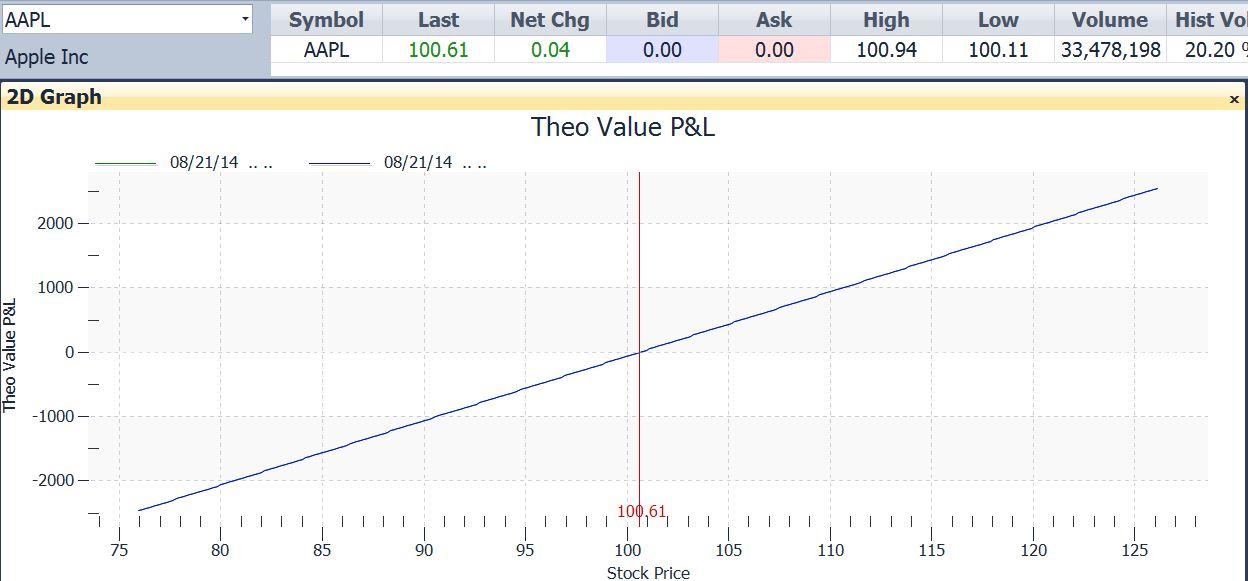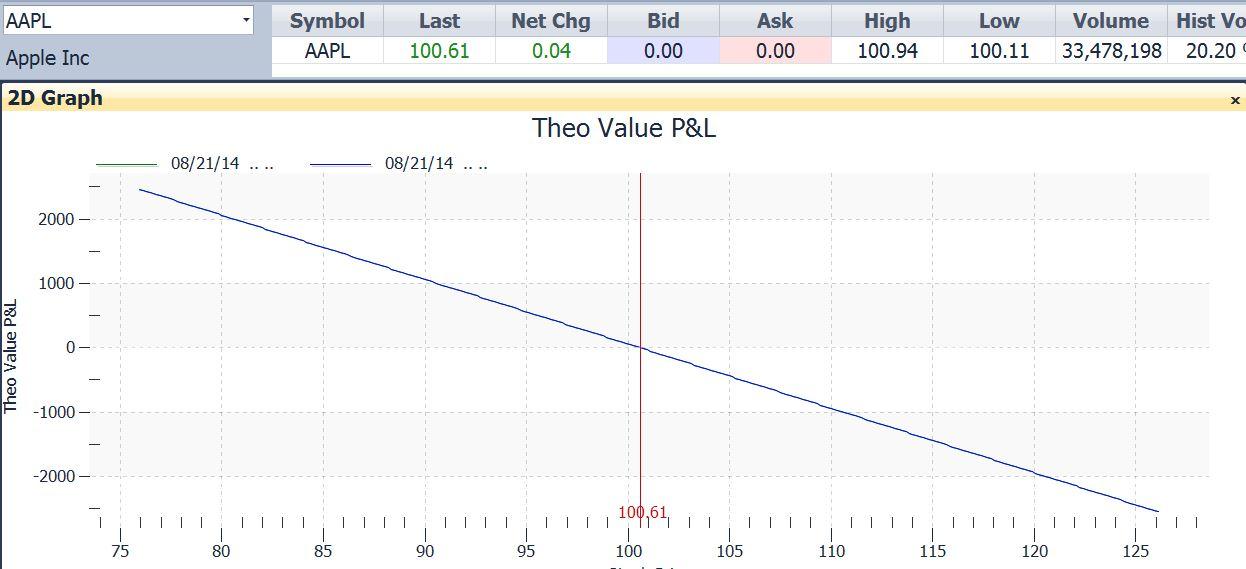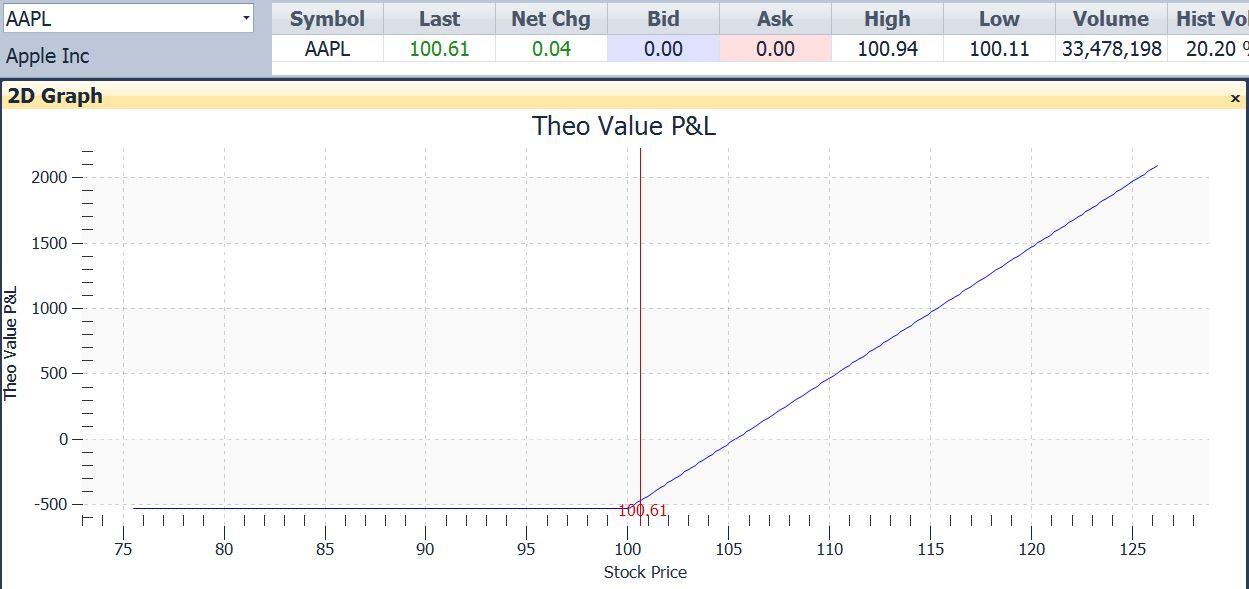When trading options, we are dealing with an instrument that is much more mathematical than other things like stocks and futures. Those are “single-dimension” instruments. Their prices go up, and they go down. Options have three dimensions. They are moved by changes in the underlying stock. But in addition, they change due to time and volatility. Visualizing the options profit picture is therefore more challenging.
Fortunately though, we have a powerful tool to help us with this. This is the option payoff diagram, also sometimes called the risk graph. This tool helps us to visualize how the value of an option position would change in response to all three of these influences. This is is an invaluable aid in creating profitable positions. In fact, that task is pretty nearly impossible without it.
Here’s how it works. First, let’s look at a payoff diagram for a simple stock position. Below is the diagram for the stock of Apple.
Figure 1 – Payoff diagram for AAPL stock – long position
Across the bottom of the chart is the scale showing different stock prices for AAPL. Today AAPL closed at $100.61 per share. The vertical red line marks this price.
The vertical scale, labeled on the left as “Theo Value P&L,” is the profit or loss on a 100-share stock position, assuming that you bought it at the present price.
The blue diagonal line plots profit or loss at any stock position. The blue line crosses the red line where Stock Price equals the current price of $100.61, and the value for theoretical profit or loss is zero. This indicates that today, tomorrow or at any other time, if the stock price stays at our cost, we would have zero profit or loss.
As we move away from that intersection toward the right, we are moving to higher stock prices. At those higher prices, our profits rise as well, so the blue line slopes up. For every dollar AAPL moves above our cost, we make $100 on our hundred shares. And if AAPL’s stock price goes down (leftward on the graph), we have a loss of $100 for every dollar (the blue line goes down to lower P&L values).
A line that slopes in this direction (upward to the right) is said to have positive slope. On payoff graphs, positive slope means that higher stock prices lead to higher profits – in other words, a bullish trade.
Until we get accustomed to it, one odd thing about this chart is that price is read left to right, instead of up and down. Another is that time is completely absent from the chart. This is not a record of what has happened to price over time. It is a projection of what will happen to profit, at any price, regardless of time.
To help further with visualizing in this way, look at the chart below. It is also a payoff graph for AAPL stock, but this time for a short position. If we were to sell the stock short, we would make money if it went down, and lose money if it went up.
Figure 2 – Payoff diagram for AAPL stock – short position
Now the blue line slopes in the opposite direction – downward as stock prices increase from left to right. This is called negative slope. It indicates that higher prices (rightward movement) lead to lower profits (lower P&L values on the vertical scale). In other words, negative slope indicates a bearish trade.
These are the simplest possible payoff diagrams. The slope is one to one, either positive or negative, over the whole chart. One dollar price change leads to one dollar difference in P&L, per share.
Now let’s look at the payoff diagram for a call option. Let’s say that we were to purchase a call option that gives us the right to buy 100 shares of AAPL at a fixed price of $100 per share, good for three months. As of now, such options are available for $5.30 per share ($530 for a 100-share contract).
Here is the diagram for that $100 November call. It shows the profit or loss as of a particular moment in time – the moment when these options expire on November 21.
Figure 3 – Payoff diagram for AAPL $100 call option purchased for $5.30
Now the blue line is not just a straight diagonal line. On the left side of our $100 strike price, the blue line is flat, at a P&L value of minus $530. This means that if AAPL is below $100 when the call options expire, we would lose the entire $530 cost of the option.
If AAPL is above $100, then the right to buy it at that price represents a discount to market value. Since there will be no time left for market value to change any further, the call at that point will be worth exactly the amount of discount that it provides. In other words, the call will be worth exactly the amount by which the price of AAPL exceeds $100. If AAPL is $106, then the call will be worth $6, and so on. There is no limit to the amount of profit that could be made, since there is no limit to how high the price of AAPL could go. So the line continues up and to the right to infinity.
Notice that the blue line crosses the zero P&L level where the stock price equals $105.30. This is because AAPL would have to be above the $100 strike price by at least our $5.30 cost for us to make any money.
So a quick glance at this graph tells us several things:
This is a bullish trade. The positive slope indicates that.
The trade has limited risk.The lowest point on the graph is at a loss of $530. Since the graph is flat and does not go any lower, that is our maximum loss.
The trade has unlimited profit.Since the line slopes up and runs off the chart, there is no limit to potential profit.
The break-even price is $105.30.We can see this because the blue P&L line crosses zero at this stock price.
All of this is instantly visible from the graph. If we add in our opinion as to where we believe price will be in the next three months, then we have a powerful tool for visualizing our profits.
This chart can do even more for us than we’ve described so far. Like any power tool, it doesn’t do the job by itself. It can make possible tasks that we could not otherwise attempt. It also requires a skilled operator to get its maximum benefit. A proper education, like that provided in our classes, is the key to getting the most out of the power tools available to us.
This content is intended to provide educational information only. This information should not be construed as individual or customized legal, tax, financial or investment services. As each individual's situation is unique, a qualified professional should be consulted before making legal, tax, financial and investment decisions. The educational information provided in this article does not comprise any course or a part of any course that may be used as an educational credit for any certification purpose and will not prepare any User to be accredited for any licenses in any industry and will not prepare any User to get a job. Reproduced by permission from OTAcademy.com click here for Terms of Use: https://www.otacademy.com/about/terms
Editors’ Picks
EUR/USD stays in tight channel above 1.0750

EUR/USD continues to fluctuate in a narrow band slightly above 1.0750 after posting small gains on Monday. Disappointing Factory Orders data from Germany limits the Euro's gains as investors keep a close eye on comments from central bankers.
GBP/USD retreats below 1.2550 as USD recovers

GBP/USD stays under modest bearish pressure and trades below 1.2550 in the European session on Tuesday. The cautious market stance helps the USD hold its ground and doesn't allow the pair to regain its traction. The Bank of England will announce policy decisions on Thursday.
Gold declines below $2,320 amid renewed US Dollar demand

Gold trades in negative territory below $2,320 as the souring mood allows the USD to find demand on Tuesday. Nevertheless, the benchmark 10-year US Treasury bond yield stays below 4.5% and helps XAU/USD limit its losses.
Ripple lawsuit develops with SEC reply under seal, XRP holders await public redacted versions

Ripple lawsuit’s latest development is SEC filing, under seal. The regulator has filed its reply brief and supporting exhibits and the documents will be made public on Wednesday, May 8.
The impact of economic indicators and global dynamics on the US Dollar

Recent labor market data suggest a cooling economy. The disappointing job creation and rising unemployment hint at a slackening demand for labor, which, coupled with subdued wage growth, could signal a slower economic trajectory.
RECOMMENDED LESSONS
Making money in forex is easy if you know how the bankers trade!
Discover how to make money in forex is easy if you know how the bankers trade!
5 Forex News Events You Need To Know
In the fast moving world of currency markets, it is extremely important for new traders to know the list of important forex news...
Top 10 Chart Patterns Every Trader Should Know
Chart patterns are one of the most effective trading tools for a trader. They are pure price-action, and form on the basis of underlying buying and...
7 Ways to Avoid Forex Scams
The forex industry is recently seeing more and more scams. Here are 7 ways to avoid losing your money in such scams: Forex scams are becoming frequent. Michael Greenberg reports on luxurious expenses, including a submarine bought from the money taken from forex traders. Here’s another report of a forex fraud. So, how can we avoid falling in such forex scams?
What Are the 10 Fatal Mistakes Traders Make
Trading is exciting. Trading is hard. Trading is extremely hard. Some say that it takes more than 10,000 hours to master. Others believe that trading is the way to quick riches. They might be both wrong. What is important to know that no matter how experienced you are, mistakes will be part of the trading process.



